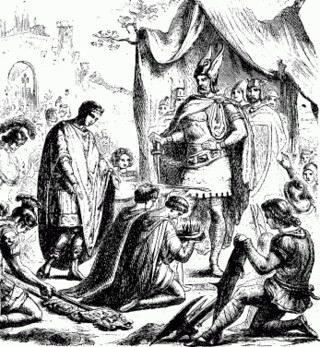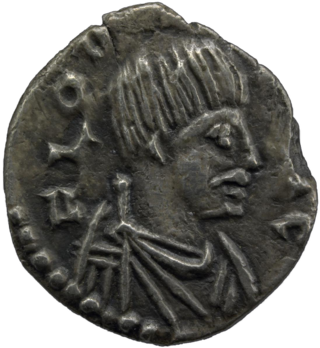
Year 476 (CDLXXVI) was a leap year starting on Thursday of the Julian calendar. At the time, it was known as the Year of the Consulship of Basiliscus and Armatus. The denomination 476 for this year has been used since the early medieval period, when the Anno Domini calendar era became the prevalent method in Europe for naming years.
The 470s decade ran from January 1, 470, to December 31, 479.
The 480s decade ran from January 1, 480, to December 31, 489.
Year 431 (CDXXXI) was a common year starting on Thursday of the Julian calendar. At the time, it was known as the Year of the Consulship of Bassus and Antiochus. The denomination 431 for this year has been used since the early medieval period, when the Anno Domini calendar era became the prevalent method in Europe for naming years.
Year 482 (CDLXXXII) was a common year starting on Friday of the Julian calendar. At the time, it was known as the Year of the Consulship of Severinus and Illus. The denomination 482 for this year has been used since the early medieval period, when the Anno Domini calendar era became the prevalent method in Europe for naming years.

Year 484 (CDLXXXIV) was a leap year starting on Sunday of the Julian calendar. At the time, it was known as the Year of the Consulship of Venantius and Theodoricus. The denomination 484 for this year has been used since the early medieval period, when the Anno Domini calendar era became the prevalent method in Europe for naming years.

Odoacer, also spelled Odovacer or Odovacar, was a barbarian soldier and statesman from the Middle Danube who deposed the Western Roman child emperor Romulus Augustulus and became the ruler of Italy (476–493). Odoacer's overthrow of Romulus Augustulus is traditionally understood as marking the end of the Western Roman Empire.

The Rugii, Rogi or Rugians, were one of the smaller Germanic peoples of Late Antiquity who are best known for their short-lived 5th-century kingdom upon the Roman frontier, near present-day Krems an der Donau in Austria. This kingdom, like those of the neighbouring Heruli and Sciri, first appears in records after the death of Attila in 453. The Rugii, Heruli, Sciri and others are believed to have moved into this region from distant homelands under pressure from the Huns, and become part of Attila's Hunnic empire which also moved and came to be based in this region. The Rugii were subsequently part of the alliance which defeated Attila's sons and the Ostrogoths at the Battle of Nedao in 454, giving their kingdom independence. In 469 they were part of a similar alliance who lost to the Ostrogoths at the Battle of Bolia, weakening their kingdom significantly.

Zeno was Eastern Roman emperor from 474 to 475 and again from 476 to 491. His reign was plagued by domestic revolts and religious dissension, but was more successful on the foreign front. He is credited with further stabilizing the Eastern empire, while the Western Roman Empire fell following the deposition of Romulus Augustulus.

Aelia Verina was the Eastern Roman empress as the wife of Leo I. She was a sister of Emperor Basiliscus. Her daughter Ariadne also became empress. Verina was the maternal grandmother of Leo II.

The Sciri, or Scirians, were a Germanic people. They are believed to have spoken an East Germanic language. Their name probably means "the pure ones".
Flavius Illus was a Roman general who played an important role in the reigns of the Eastern Emperors Zeno and Basiliscus.
Flavius Marcianus was a member of the Leonid dynasty. The son of the Western emperor Anthemius, Marcianus married Leontia, the daughter of the Eastern Roman emperor Leo I. He was consul twice, and in 479 unsuccessfully attempted to overthrow the emperor Zeno. After his capture he was forced to become a monk; he escaped and raised an army but was defeated and recaptured by Flavius Appalius Illus Trocundes. In 484, when the Isaurian general Illus revolted against Zeno, Marcianus was freed and Illus proclaimed him emperor, before deposing him in favour of Leontius.

Leontius was a general of the Eastern Roman Empire and claimant to the throne who led a rebellion against Emperor Zeno in 484–488.

The Kingdom of the Rugii or Rugiland was established by the Germanic Rugii in present-day Austria in the 5th century.
Onoulphus, also Onoulf, Unulf and Hunulf was a general of the late fifth century of Scirian origin. He served as magister militum per Illyricum from 477 to 479 as a general of the Eastern Roman Empire, then afterwards was a general for his brother Odoacer, king of Italy, until their death.
John the Scythian was a general and a politician of the Eastern Roman Empire who fought against the usurper Leontius (484–488) and in the Isaurian War (492–497).
The Isaurian War was a conflict that lasted from 492 to 497 and that was fought between the army of the Eastern Roman Empire and the rebels of Isauria. At the end of the war, Eastern Emperor Anastasius I regained control of the Isauria region and the leaders of the revolt were killed.
Feletheus was the king of the Rugii from 475 to 487.
Frideric was the leader of the Germanic Rugians from 487 to 492/493.







